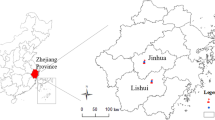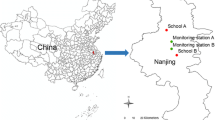Abstract
The objective of this study is to examine the association between ambient temperature and children’s lung function in Baotou, China. We recruited 315 children (8–12 years) from Baotou, China in the spring of 2004, 2005, and 2006. They performed three successive forced expiratory measurements three times daily (morning, noon, and evening) for about 5 weeks. The highest peak expiratory flow (PEF) was recorded for each session. Daily data on ambient temperature, relative humidity, and air pollution were monitored during the same period. Mixed models with a distributed lag structure were used to examine the effects of temperature on lung function while adjusting for individual characteristics and environmental factors. Low temperatures were significantly associated with decreases in PEF. The effects lasted for lag 0–2 days. For all participants, the cumulative effect estimates (lag 0–2 days) were −1.44 (−1.93, −0.94) L/min, −1.39 (−1.92, −0.86) L/min, −1.40 (−1.97, −0.82) L/min, and −1.28 (−1.69, −0.88) L/min for morning, noon, evening, and daily mean PEF, respectively, associated with 1 °C decrease in daily mean temperature. Generally, the effects of temperature were slightly stronger in boys than in girls for noon, evening, and daily mean PEF, while the effects were stronger in girls for morning PEF. PM2.5 had joint effects with temperature on children’s PEF. Higher PM2.5 increased the impacts of low temperature. Low ambient temperatures are associated with lower lung function in children in Baotou, China. Preventive health policies will be required for protecting children from the cold weather.


Similar content being viewed by others
References
Analitis A, Katsouyanni K, Biggeri A, Baccini M, Forsberg B, Bisanti L, Kirchmayer U, Ballester F, Cadum E, Goodman PG, Hojs A, Sunyer J, Tiittanen P, Michelozzi P (2008) Effects of cold weather on mortality: results from 15 European cities within the PHEWE project. Am J Epidemiol 168(12):1397–1408
Anderson GB, Bell ML (2011) Heat waves in the United States: mortality risk during heat waves and effect modification by heat wave characteristics in 43 U.S. communities. Environ Health Perspect 119(2):210–218
Basu R (2009) High ambient temperature and mortality: a review of epidemiologic studies from 2001 to 2008. Environ Health 8:40
Basu R, Ostro BD (2008) A multicounty analysis identifying the populations vulnerable to mortality associated with high ambient temperature in California. Am J Epidemiol 168(6):632–637
Collaco JM, McGready J, Green DM, Naughton KM, Watson CP, Shields T, Bell SC, Wainwright CE, Cutting GR (2011) Effect of temperature on cystic fibrosis lung disease and infections: a replicated cohort study. PLoS One 6(11):e27784
Core Team R (2013) R: a language and environment for statistical computing. R Foundation for Statistical Computing, Vienna, Austria
Delfino RJ, Staimer N, Tjoa T, Gillen D, Kleinman MT, Sioutas C, Cooper D (2008) Personal and ambient air pollution exposures and lung function decrements in children with asthma. Environ Health Perspect 116(4):550–558
Donaldson GC, Seemungal T, Jeffries DJ, Wedzicha JA (1999) Effect of temperature on lung function and symptoms in chronic obstructive pulmonary disease. Eur Respir J 13(4):844–849
Driessen JM, van der Palen J, van Aalderen WM, de Jongh FH, Thio BJ (2012) Inspiratory airflow limitation after exercise challenge in cold air in asthmatic children. Respir Med 106(10):1362–1368
Guo Y, Barnett AG, Pan X, Yu W, Tong S (2011) The impact of temperature on mortality in Tianjin, China: a case-crossover design with a distributed lag nonlinear model. Environ Health Perspect 119(12):1719–1725
Guo Y, Jiang F, Peng L, Zhang J, Geng F, Xu J, Zhen C, Shen X, Tong S (2012) The association between cold spells and pediatric outpatient visits for asthma in Shanghai, China. PLoS One 7(7):e42232
Guo Y, Barnett AG, Tong S (2013a) Spatiotemporal model or time series model for assessing city-wide temperature effects on mortality? Environ Res 120:55–62
Guo Y, Li S, Zhang Y, Armstrong B, Jaakkola JJ, Tong S, Pan X (2013b) Extremely cold and hot temperatures increase the risk of ischaemic heart disease mortality: epidemiological evidence from China. Heart 99(3):195–203
Holgate ST, Koren HS, Samet JM, Maynard RL (1999) Air pollution and health. Academic, London
James Gauderman W, McConnell R, Gilliland F, London S, Thomas D, Avol E, Vora H, Berhane K, Rappaport EB, Lurmann F (2000) Association between air pollution and lung function growth in southern California children. Am J Respir Crit Care Med 162(4):1383–1390
Koskela HO (2007) Cold air-provoked respiratory symptoms: the mechanisms and management. Int J Circumpolar Health 66(2):91–100
Koskela HO, Koskela AK, Tukiainen HO (1996) Bronchoconstriction due to cold weather in COPD—the roles of direct airway effects and cutaneous reflex mechanisms. Chest 110(3):632–636
Li S, Baker PJ, Jalaludin BB, Guo Y, Marks GB, Denison LS, Williams GM (2014a) Are childrens asthmatic symptoms related to ambient temperature? A panel study in Australia. Environ Res 133:239–245
Li S, Baker PJ, Jalaludin BB, Guo Y, Marks GB, Denison LS, Williams GM (2014b) An Australian national panel study of diurnal temperature range and children’s respiratory health. Ann Allergy Asthma Immunol 112(4):348–353
Li S, Baker PJ, Jalaludin BB, Marks GB, Denison LS, Williams GM (2014c) Ambient temperature and lung function in children with asthma in Australia. Eur Respir J 43(4):1059–1066
Madaniyazi L, Guo Y, Ye X, Kim D, Zhang Y, Pan X (2013) Effects of airborne metals on lung function in inner Mongolian schoolchildren. J Occup Environ Med 55(1):80–86
Mann M, Patel K, Reardon JZ, Goldstein M, Godar TJ, ZuWallack RL (1993) The influence of spring and summer New England meteorologic conditions on the respiratory status of patients with chronic lung disease. Chest 103(5):1369–1374
O’Neill MS, Zanobetti A, Schwartz J (2003) Modifiers of the temperature and mortality association in seven US cities. Am J Epidemiol 157(12):1074–1082
Pellegrino R, Viegi G, Brusasco V, Crapo RO, Burgos F, Casaburi R, Coates A, van der Grinten CP, Gustafsson P, Hankinson J, Jensen R, Johnson DC, MacIntyre N, McKay R, Miller MR, Navajas D, Pedersen OF, Wanger J (2005) Interpretative strategies for lung function tests. Eur Respir J 26(5):948–968
Pope CA III, Ezzati M, Dockery DW (2009) Fine-particulate air pollution and life expectancy in the United States. N Engl J Med 360(4):376–386
Schroeder EB, Welch VL, Couper D, Nieto FJ, Liao D, Rosamond WD, Heiss G (2003) Lung function and incident coronary heart disease: the Atherosclerosis Risk in Communities Study. Am J Epidemiol 158(12):1171–1181
Sheffield PE, Landrigan PJ (2011) Global climate change and children’s health: threats and strategies for prevention. Environ Health Perspect 119(3):291
Sin DD, Wu L, Man SF (2005) The relationship between reduced lung function and cardiovascular mortality: a population-based study and a systematic review of the literature. Chest 127(6):1952–1959
Smargiassi A, Goldberg MS, Wheeler AJ, Plante C, Valois MF, Mallach G, Kauri LM, Shutt R, Bartlett S, Raphoz M, Liu L (2014) Associations between personal exposure to air pollutants and lung function tests and cardiovascular indices among children with asthma living near an industrial complex and petroleum refineries. Environ Res 132:38–45
Wilmshurst PT, Nuri M, Crowther A, Webb-Peploe MM (1989) Cold-induced pulmonary oedema in scuba divers and swimmers and subsequent development of hypertension. Lancet 1(8629):62–65
Wood SN (2011) Fast stable restricted maximum likelihood and marginal likelihood estimation of semiparametric generalized linear models. J R Stat Soc Ser B Stat Methodol 73(1):3–36
Wu SW, Deng FR, Hao Y, Wang X, Zheng CJ, Lv HB, Lu XL, Wei HY, Huang J, Qin Y, Shima M, Guo XB (2014) Fine particulate matter, temperature, and lung function in healthy adults: findings from the HVNR study. Chemosphere 108:168–174
Xu ZW, Etzel RA, Su H, Huang CR, Guo YM, Tong SL (2012) Impact of ambient temperature on children’s health: a systematic review. Environ Res 117:120–131
Ye X, Wolff R, Yu W, Vaneckova P, Pan X, Tong S (2012) Ambient temperature and morbidity: a review of epidemiological evidence. Environ Health Perspect 120(1):19–28
Acknowledgments
This study was supported by the National Research Foundation (NRF), South Korea (2004–2008); National Natural Science Foundation of China (#81273033); and Shanghai Key Laboratory of Meteorology and Health (#QXJK201305). Shanshan Li was supported by the University of Queensland Graduate School International Travel Award.
Conflict of interest
The authors declare no competing financial interests.
Author information
Authors and Affiliations
Corresponding authors
Electronic supplementary material
Below is the link to the electronic supplementary material.
ESM 1
(DOC 104 kb)
Rights and permissions
About this article
Cite this article
Li, S., Guo, Y., Williams, G. et al. The association between ambient temperature and children’s lung function in Baotou, China. Int J Biometeorol 59, 791–798 (2015). https://doi.org/10.1007/s00484-014-0897-2
Received:
Revised:
Accepted:
Published:
Issue Date:
DOI: https://doi.org/10.1007/s00484-014-0897-2




